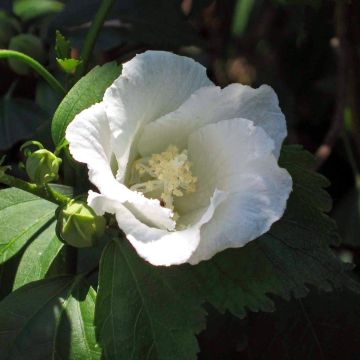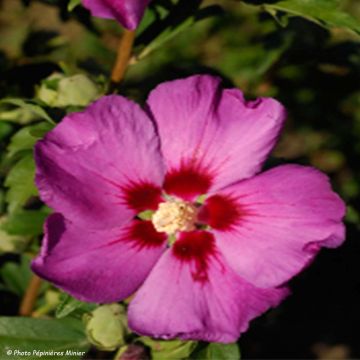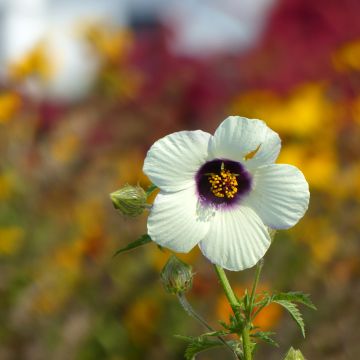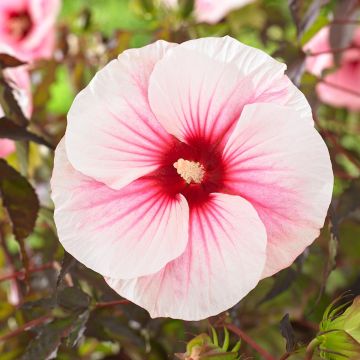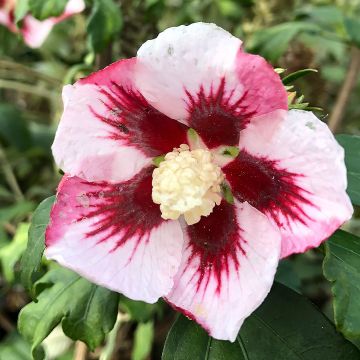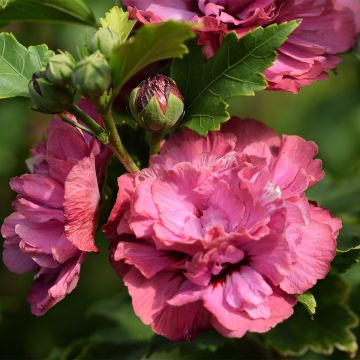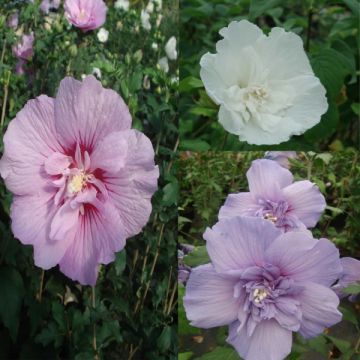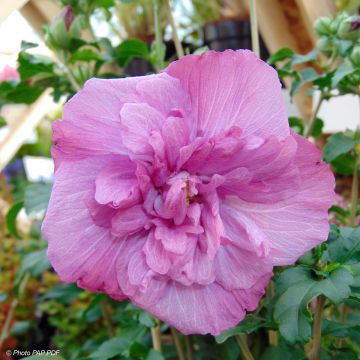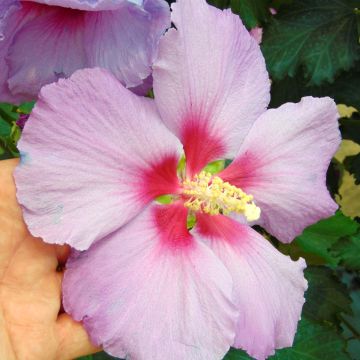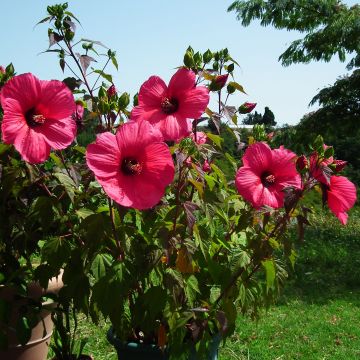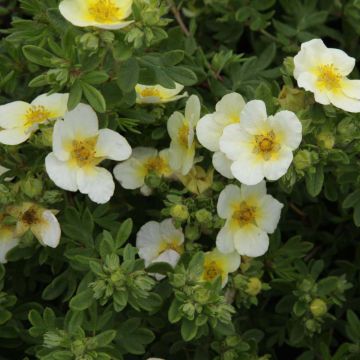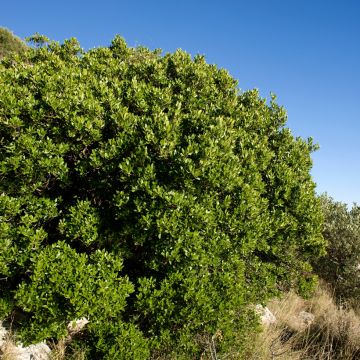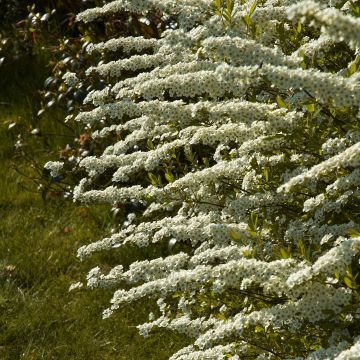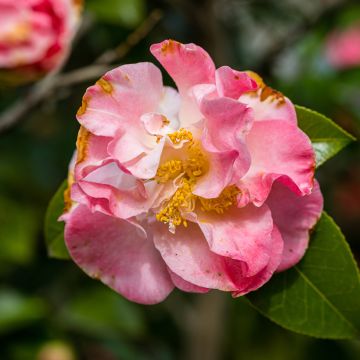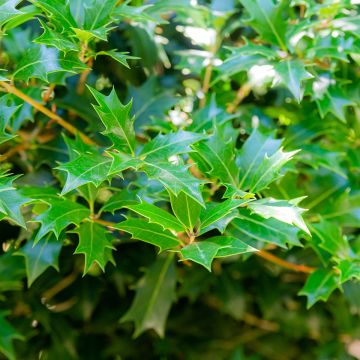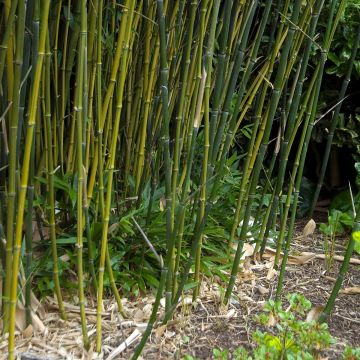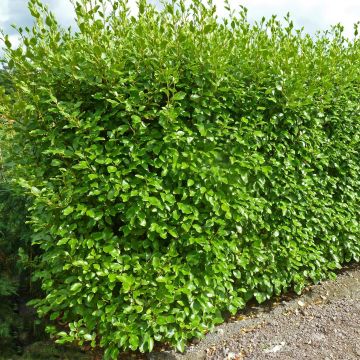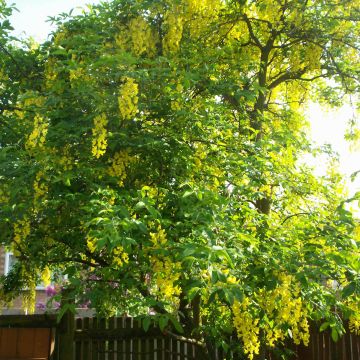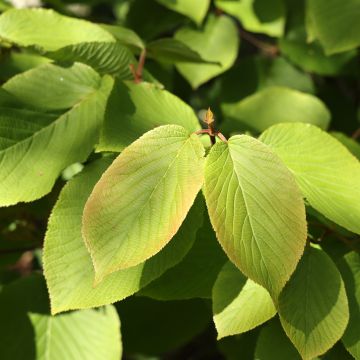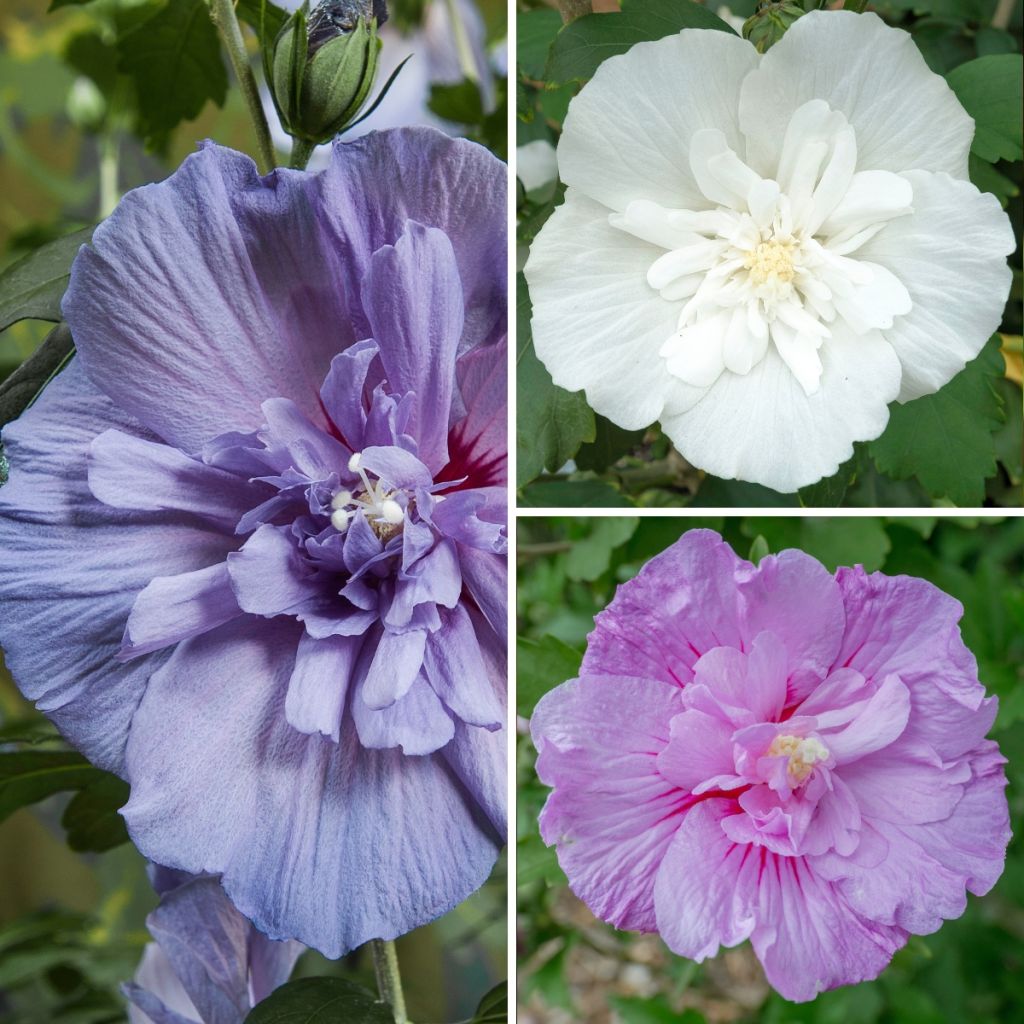

Hibiscus syriacus Three Sisters (Lavender Chiffon, Blue Chiffon, White Chiffon) - Rose of Sharon
Hibiscus syriacus Three Sisters (Lavender Chiffon, Blue Chiffon, White Chiffon) - Rose of Sharon
Hibiscus syriacus Three Sisters ® (Lavender Chiffon, Blue Chiffon, White Chiffon)
Common Hibiscus, Rose of Sharon, Syrian ketmia, St Joseph's rod, Garden Hibiscus
This item cannot be shipped to the selected country
Delivery charge from €5.90
More information
Schedule delivery date,
and select date in basket
This plant carries a 24 months recovery warranty
More information
We guarantee the quality of our plants for a full growing cycle, and will replace at our expense any plant that fails to recover under normal climatic and planting conditions.
From €5.90 for pickup delivery and €6.90 for home delivery
Express home delivery from €8.90.
Does this plant fit my garden?
Set up your Plantfit profile →
Description
The Hibiscus syriacus Three Sisters brings together three different varieties of Althea in a single pot to dazzle and amaze those around you with multicoloured white, blue, and mauve flowers. This composition is made up of three variations of the same variety, all of which have large double flowers with a charmingly wrinkled centre. By combining these three bushes, you can create a beautiful decoration for your terrace or balcony. Hibiscus syriacus, or Tree Mallow, can tolerate cold and heat very well. It will reward you with a long period of summer flowering that can even extend into autumn.
The Hibiscus syriacus, also known as Garden Hibiscus or Tree Mallow, is a hardy deciduous shrub in regions with cooler climates but remains evergreen in warmer areas. It belongs to Malvaceae's large family, comprising over 240 genera and 4200 species. The Hibiscus syriacus is native to temperate regions of Asia, such as China and India, and there are numerous remarkable cultivars available on the market today, showcasing the beauty of their flowers that resemble the tropical cousin, the Hibiscus rosa-sinensis. This robust shrub offers a wide range of colours, making it a popular choice for gardeners.
Three Sisters offers an easy solution for those who struggle to choose from various colours. With Three Sisters, you can get three different colours in one pot, all from the same range of flowers. These flowers were developed by Dr Roderick Woods, an English breeder, and share the same wrinkled appearance with large flowers about 10 cm (3.9 in) in diameter. The first variety available in the range is Lavender Chiffon, which has a bushy habit with numerous, rather upright stems. The Hibiscus plant is medium-sized, reaching up to 2m (6ft 7in) in height when grown in open ground, with a spread of 1m (3ft 4in) to 1.50m (4ft 11in). Its compactness makes it ideal for container culture, particularly for composition purposes. From July to October, the plant blooms with large, characteristic corollas typical of the Hibiscus genus. Although the flowers are short-lived, they are constantly replaced by new ones. These flowers have a beautiful double appearance with many wrinkled petals in the centre, which gives them a charming look. Their colour is a mix of mauve and lavender with red streaks towards the centre. The deciduous leaves are green and simple with a heart-shaped and lobed appearance. They have a serrated and wavy edge.
The second type of Hibiscus, White Chiffon, has similar vegetative characteristics to the other two varieties. It has a dense and branched habit but stands apart with its immaculate white flowers. Unlike the other two varieties, the White Chiffon's flowers do not have central red streaks and are double with a wrinkled centre. They provide a nice contrast to the medium green foliage and the flowers of the other two Hibiscus types in the arrangement.
Dr Woods' latest addition to their range is Blue Chiffon. This hibiscus variety borrowed the colour from the famous 'Blue Bird', one of the most well-known single blue-flowered varieties. The flower of Blue Chiffon is double, with very fine central petals marked with red towards their base, unlike the petals on the periphery. This composition of Hibiscus Three Sisters is quite hardy and can withstand temperatures as low as -20°C (-4 °F). It flourishes in full sun or dappled shade in hot climates. It can adapt to most soils, even limestone, if planted in the ground. It requires only a few waterings in summer to support flowering and prevent premature yellowing of the leaves. Although it tolerates drought well, remember that a potted plant cannot draw water from deep as it would in open ground. Prune it relatively short at the end of winter, balancing each variety so that none dominates the others.
The Althaea Three Sisters are great for decorating a terrace or adding interest to a pathway. You can pair them with other potted plants for an even more inviting space. The Red Lady Shrubby Cinquefoil is an excellent choice if you're looking for a low-growing shrub that blooms for an extended period. It produces bright red flowers with yellow stamens from May to September. For a plant that's easy to grow in a container and has fragrant blue-violet flowers in July and August, consider the Munstead English Lavender. And if you're looking for a plant with beautiful grey foliage and long white flowering, the Silver Bush Morning Glory is an excellent option. This silver bindweed produces funnel-shaped flowers from April to May that repeat until summer.
Report an error about the product description
Hibiscus syriacus Three Sisters (Lavender Chiffon, Blue Chiffon, White Chiffon) - Rose of Sharon in pictures
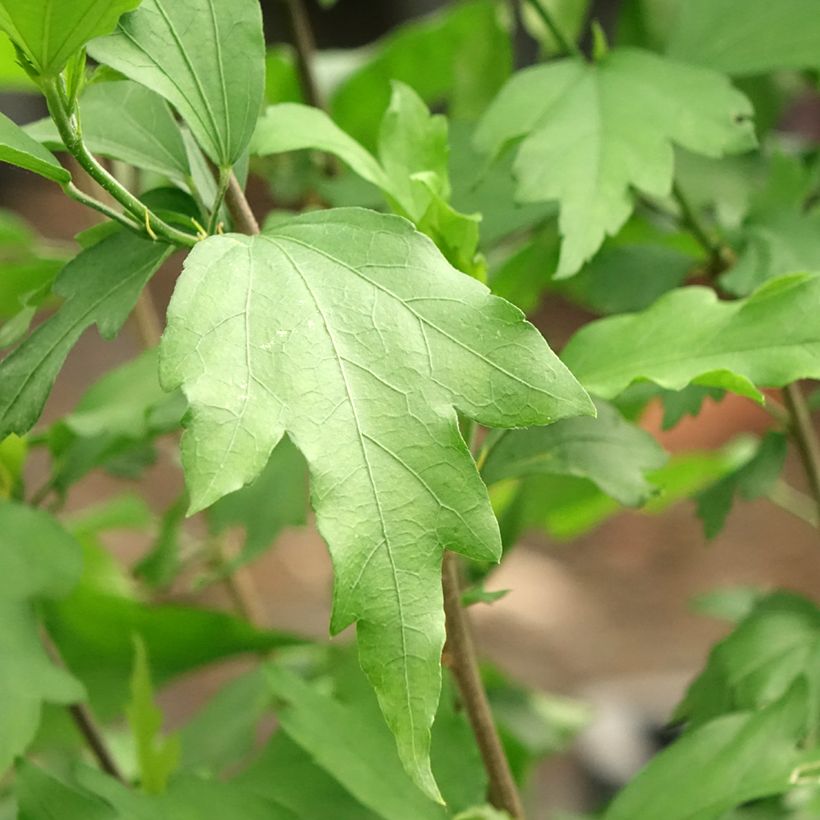

Plant habit
Flowering
Foliage
Botanical data
Hibiscus
syriacus
Three Sisters ® (Lavender Chiffon, Blue Chiffon, White Chiffon)
Malvaceae
Common Hibiscus, Rose of Sharon, Syrian ketmia, St Joseph's rod, Garden Hibiscus
Cultivar or hybrid
Other Hibiscus
Planting and care
Before planting the Hibiscus syriacus Three Sisters:
- Consider whether you want to plant it in the ground or in a pot for decoration.
- If you choose a pot, use a thick terracotta decorative pot or a plastic pot with inner and outer walls separated by an air gap.
- Add some compost and sand to your garden soil to improve its quality.
Soak the root ball well in a bucket before planting or repotting, and then water it once in the soil. Choose a sunny location for planting to promote flowering. Altheas are more beautiful and floriferous when planted in soil that retains moisture in summer. If necessary, mulch the base of these generous bushes.
Remember that it's normal for this bush to have slow growth before May.
Planting period
Intended location
Care
This item has not been reviewed yet - be the first to leave a review about it.
Hedge shrubs
Haven't found what you were looking for?
Hardiness is the lowest winter temperature a plant can endure without suffering serious damage or even dying. However, hardiness is affected by location (a sheltered area, such as a patio), protection (winter cover) and soil type (hardiness is improved by well-drained soil).

Photo Sharing Terms & Conditions
In order to encourage gardeners to interact and share their experiences, Promesse de fleurs offers various media enabling content to be uploaded onto its Site - in particular via the ‘Photo sharing’ module.
The User agrees to refrain from:
- Posting any content that is illegal, prejudicial, insulting, racist, inciteful to hatred, revisionist, contrary to public decency, that infringes on privacy or on the privacy rights of third parties, in particular the publicity rights of persons and goods, intellectual property rights, or the right to privacy.
- Submitting content on behalf of a third party;
- Impersonate the identity of a third party and/or publish any personal information about a third party;
In general, the User undertakes to refrain from any unethical behaviour.
All Content (in particular text, comments, files, images, photos, videos, creative works, etc.), which may be subject to property or intellectual property rights, image or other private rights, shall remain the property of the User, subject to the limited rights granted by the terms of the licence granted by Promesse de fleurs as stated below. Users are at liberty to publish or not to publish such Content on the Site, notably via the ‘Photo Sharing’ facility, and accept that this Content shall be made public and freely accessible, notably on the Internet.
Users further acknowledge, undertake to have ,and guarantee that they hold all necessary rights and permissions to publish such material on the Site, in particular with regard to the legislation in force pertaining to any privacy, property, intellectual property, image, or contractual rights, or rights of any other nature. By publishing such Content on the Site, Users acknowledge accepting full liability as publishers of the Content within the meaning of the law, and grant Promesse de fleurs, free of charge, an inclusive, worldwide licence for the said Content for the entire duration of its publication, including all reproduction, representation, up/downloading, displaying, performing, transmission, and storage rights.
Users also grant permission for their name to be linked to the Content and accept that this link may not always be made available.
By engaging in posting material, Users consent to their Content becoming automatically accessible on the Internet, in particular on other sites and/or blogs and/or web pages of the Promesse de fleurs site, including in particular social pages and the Promesse de fleurs catalogue.
Users may secure the removal of entrusted content free of charge by issuing a simple request via our contact form.
The flowering period indicated on our website applies to countries and regions located in USDA zone 8 (France, the United Kingdom, Ireland, the Netherlands, etc.)
It will vary according to where you live:
- In zones 9 to 10 (Italy, Spain, Greece, etc.), flowering will occur about 2 to 4 weeks earlier.
- In zones 6 to 7 (Germany, Poland, Slovenia, and lower mountainous regions), flowering will be delayed by 2 to 3 weeks.
- In zone 5 (Central Europe, Scandinavia), blooming will be delayed by 3 to 5 weeks.
In temperate climates, pruning of spring-flowering shrubs (forsythia, spireas, etc.) should be done just after flowering.
Pruning of summer-flowering shrubs (Indian Lilac, Perovskia, etc.) can be done in winter or spring.
In cold regions as well as with frost-sensitive plants, avoid pruning too early when severe frosts may still occur.
The planting period indicated on our website applies to countries and regions located in USDA zone 8 (France, United Kingdom, Ireland, Netherlands).
It will vary according to where you live:
- In Mediterranean zones (Marseille, Madrid, Milan, etc.), autumn and winter are the best planting periods.
- In continental zones (Strasbourg, Munich, Vienna, etc.), delay planting by 2 to 3 weeks in spring and bring it forward by 2 to 4 weeks in autumn.
- In mountainous regions (the Alps, Pyrenees, Carpathians, etc.), it is best to plant in late spring (May-June) or late summer (August-September).
The harvesting period indicated on our website applies to countries and regions in USDA zone 8 (France, England, Ireland, the Netherlands).
In colder areas (Scandinavia, Poland, Austria...) fruit and vegetable harvests are likely to be delayed by 3-4 weeks.
In warmer areas (Italy, Spain, Greece, etc.), harvesting will probably take place earlier, depending on weather conditions.
The sowing periods indicated on our website apply to countries and regions within USDA Zone 8 (France, UK, Ireland, Netherlands).
In colder areas (Scandinavia, Poland, Austria...), delay any outdoor sowing by 3-4 weeks, or sow under glass.
In warmer climes (Italy, Spain, Greece, etc.), bring outdoor sowing forward by a few weeks.

































